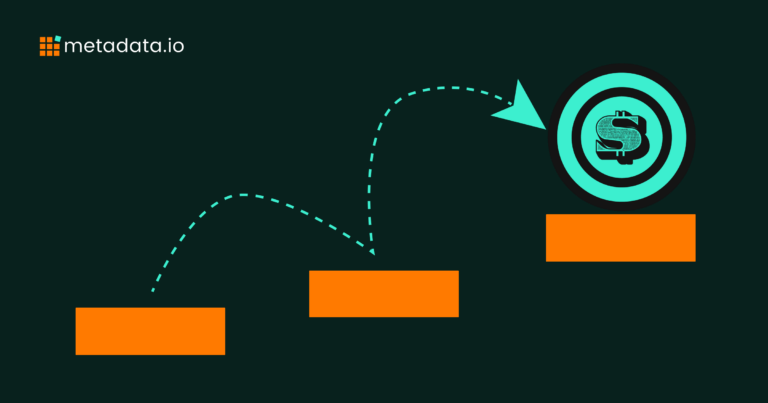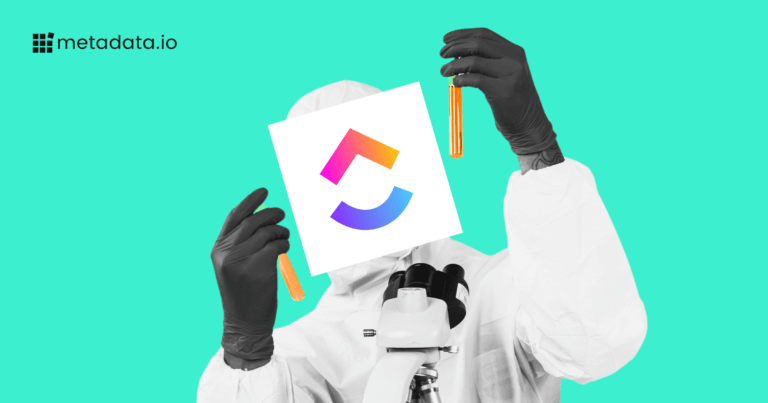Building B2B Audiences Across Native Ad Channels with Metadata
This is the fifth post in our new content series, Meta With Metadata. We’re giving you an inside look at how our Marketing team uses our own product to automate paid campaigns and drive more revenue.
Building accurate audiences in native ad channels is way too painful for B2B marketers.
Here are the three complaints we hear most from B2B marketers about it:
- Native ad channels have limited targeting criteria
- User-generated criteria available in native channels is lying to you
- Audience data exists in each channel in siloes
I’ll dive into those reasons, but that’s the high-level view of why building effective B2B audiences in native isn’t optimal.
Here’s how I do it, and why it’s so much better (and easier) in Metadata.
How I build B2B audiences (in or out of Metadata)
There are really no excuses anymore for B2B marketers.
Whether you’re running ads on Facebook, LinkedIn, Google, or a display network, you have every lever imaginable to target your buyers with laser-like precision.
This limitless potential drives the demand for advertising; digital ad spend is expected to surpass $626b this year, up from about $522b in 2021.
But this demand is also the invisible hand that’s forcing Facebook, LinkedIn, and others to innovate quickly. So quickly that their incredibly powerful tools have become exponentially complex—and this doesn’t include the extra complexity that’ll arrive when Google sunsets third-party cookies next year.
This level of complexity keeps even the most seasoned B2B marketers at bay, preventing them from building audiences that generate pipeline and revenue.
Instead of getting lost in the complexity, I keep my builds simple by asking myself two questions:
- Which companies do I want to reach with my ads?
- Which people at those companies should see my ads?
That’s it. Let’s break that down.
I start with a list of target companies
Unless you sell a product with infinite use cases—think Loom and Zoom—there’s a list of logos you want on your home page. I know for a fact there’s a list of companies your sales team wants to have a meeting with. If you don’t think so, just sit with them for five minutes (probably less).
For Metadata, that’s SaaS companies of a certain size.
I want people at these companies to see my ads; clicks or impressions from others are a waste.
To make sure my ads land on the screens of the right people at the right companies, I create a list of target URLs. If you’ve invested in account-based marketing (ABM) before, this step won’t be new. B2B marketers commonly refer to these as total addressable market (TAM) lists and target account lists.
Your goal is simple: List every company you’d love to see on your website. If you wouldn’t want a logo floating on your home page’s carousel, it doesn’t belong on this list.
Source this data from a few places:
- ZoomInfo
- Crunchbase
- Your CRM (Salesforce, HubSpot, etc.)
- Your sales team
By controlling my list, I can pre-qualify each company, go beyond broad targeting criteria, e.g., revenue, size, and industry, and ultimately make sure my ads are landing in front of the people at companies who could actually use Metadata.
I layer on job titles to ensure 100% relevancy
Building a target account list is great, but what’s the point if I’m not getting my ads in front of the right people at those companies? To deliver ads with 100% relevancy, I stack persona-based targeting criteria on top of my account list.
No, I’m not talking about targeting “Marketers” or “VPs” on LinkedIn who work at these companies. Those job titles are too broad and open the door to media waste.
Think about it: How many types of B2B marketers are there? A lot. If I’m running a campaign for Metadata, do I want telephone and door-to-door marketers to see my ads? No.
I want digital marketers to see them. But if I tell LinkedIn or Facebook to reach all “Marketers,” anyone who falls into that broad bucket will see them.
To target with a high degree of certainty, all you have to do is layer on specific job functions—a lot of them—on top of your account list.
Here’s how I’d do that if I were building a campaign targeting finance companies:
- Start with keywords like accounting, compliance, cost controller, data analyst, credit controller, treasury, etc.
- Find synonyms of those keywords.
- Search for these keywords in LinkedIn and other databases to find every job title and variation.
I can now add this list of job titles to my list of company URLs and assemble an audience that’s achieved 100% relevancy.
I’ll end with this—and I really mean it. When you have the ability to upload job titles and company URLs, there’s no excuse for shit targeting. When you pre-qualify job titles and companies, every dollar you spend is on an MQL.
Pro Tip: Aim for a minimum audience size of 10,000 people—anything less, and your CPMs will go through the roof. In a perfect world, your audience will surpass 50,000 people without losing relevance, which may require you to build and bundle multiple smaller audiences.
What’s the difference between audience building natively and in Metadata?
I’m often asked to describe the difference between building audiences in native channels and Metadata, and I always say this:
You can build solid B2B audiences in both, but native ad channels have pitfalls that’ll stifle even the most seasoned performance marketers.
Let me explain.
Building audiences in the native ad channels
The fundamental problem with building audiences in native channels is the targeting data is user-generated. When I signed up for LinkedIn, for example, I entered my job title, company, and location.
I did the same for my skills related to content marketing, blogging, and social media.
This contact- and company-level information is LinkedIn’s selling point to marketers (and every other native channel). On the surface, this first-party data should allow marketers to target people who meet their ideal customer profile (ICP) to a tee.


Here’s the thing: People lie (or at least stretch the truth). I could claim to be anywhere and work for any company.
I could easily add ChatGPT to my skills and ask all my connections to endorse me. But is this really one of my specialties? Heck no, but in LinkedIn’s eyes, it is. Companies targeting related skills will operate under that same assumption.
This is just one reason why building audiences in native ad channels can be so unreliable.
The (built-in) limitations of native ad channels
On top of people stretching the truth, native channels also have limitations tied to the channels themselves, but also human nature.
The reason I’ll always say that effective targeting is possible natively is that all the levers are there. Most B2B marketers just don’t take full advantage of them because they don’t have time or don’t know how to use them. That’s inherently human.
Instead of creating specific audiences with an exhaustive list of job titles and URLs (like I outlined above), they use Size, Revenue, Industry, Country, and other relatively high-level criteria.
This is a problem for two reasons:
- They’re vague and don’t guarantee you’re reaching your ICP
- Native channels only let you add so many criteria per campaign
For example, you can only target 100 unique job titles per LinkedIn campaign. That may seem like enough to cover your bases, but I guarantee there’s more opportunity out there—and for each job title you can’t add, you’re tempting the wastage gods.
Can you create multiple lists of 100 job titles and run separate campaigns? Sure, but again, that’s time-consuming and a pain in the butt. You must also build your audiences individually if you’re running them across different channels, e.g., Facebook, LinkedIn, Instagram, Google, etc.
That’s even more time-consuming, but it also makes experimentation freakin’ hard.
(Fun fact: You can include up to 500 unique job titles in Metadata. Less time, more opportunity.)
Building audiences in Metadata
Ask me to highlight the power of Metadata, and I’ll whip out this image every single time. The difference between building audiences natively and in Metadata is…data.

When you build an audience in LinkedIn or Facebook, you have access to one dataset—theirs. (This is the “channel targeting” column all the way to the right.) With Metadata, you can build with so much more.
Metadata sources:
- User-generated data (the same data in the native channels)
- Data providers, e.g., Aberdeen, Bombora, and Leadsift
That second bullet is the differentiator.
Not only can you access the same native data, but you can layer firmographic (company size, revenue, industry, etc.), technographic (tech stack), and intent data on top of it. You can even add first-party data from Salesforce and HubSpot to guarantee you’re hitting accounts with open opportunities.
A word on offers: All data sources can work for any offer types, as long as the inputs are relevant and high quality. Audience is for relevance, the creative is to make those people act.
Metadata allows you to get creative with your targeting and find best-fit people ready to buy so you can avoid wasting your marketing budget in a down economy.
This is only possible with MetaMatch.
It gets better. You can build audiences across channels, including Facebook, where people typically use their personal emails to log in. That means you can reach B2B audiences on Facebook, despite your contemporaries telling you that “buyers aren’t on there.”
News flash: They are. Almost three billion people use Facebook, and I’d wager a bet that 99% of your audience is logging in every month. While your audience may not be in the “business mindset” on Facebook, that doesn’t mean you can’t influence them when they’re scrolling.
Don’t believe me? Consider this data comparing demo requests on LinkedIn and Facebook:
LinkedIn


While LinkedIn outperforms Facebook in many ways, the latter still shines:
- Facebook’s Lead to Triggered Opp %: 4.1x that of LinkedIn
- Triggered Opp to Win %: 2x that of LinkedIn
- Cost Per Triggered Opp Won: 82% lower on Facebook
There’s untapped value in Facebook, and you can scoop it up, thanks to MetaMatch’s personal-to-corporate identity graph, which matches multiple personal emails to a business profile.
The link between accurate audiences and a healthy pipeline
Whether you’ve set your sights on demand, leads, or something in between, you don’t want to waste your budget on people who aren’t a fit for your product or service; that’s why it’s critical you build accurate audiences and get laser-focused on your ICP.
The impact of accurate B2B audiences is three-fold:
- You can accelerate pipeline: Target companies—and people at them—with open opportunities. You can target late-stage deals on the cusp of closing with ads promoting social proof.
- You can cross-sell: Target customers with relevant offers that get them thinking beyond their current use case for your product and generate new opportunities for your sales team.
- You can reduce churn: Target high-risk accounts with content and messaging that strengthens your relationship and reaffirms their loyalty.
Accurate B2B audiences are within reach natively and in Metadata—I won’t deny that—but the latter gives you a helluva lot easier way to build them with precision, put your best foot forward, and give your sales team the pipeline they need to hit their revenue targets.



